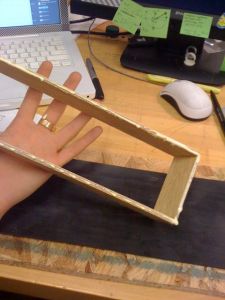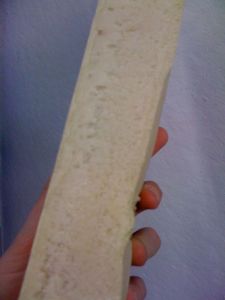For this re-do week, I wanted to actually make a molding machine that worked and that I could use to produce casts of stone for my studio project. My plan was to do something quite similar to what some other people in the class had been trying (Asli, Tiffany), but using sticks to change a pattern in the surface of a mold.
As you can see, there was one so-so result, and then the destruction of the mold, making this a not-so successful molding machine, but really only because of my error in choice of casting materials.
SO – I defined the shape of my brick (which should be for a 1:25 detail structural model that I’m working on) and cut a couple of strips of wood to be the boundaries for my molding box.
The underside of the molding box would be comprised of a few layers. 1 (closest to the mold) a flexible rubber sheet, 2 (holding the rubber sheet in place) a particleboard wooden frame with a window cut out so that the rubber sheet was exposed for the face of the mold), 3 a piece of foam-core with a pattern of holes punched into it, housing a series of pegs that could change place and form the variable component of my molding machine.
the peg board and the rubber sheet frame board.
the wooden frame sealed with wood glue being attached to the upper side of the rubber-topped board. I also used hot glue to seal the edges, just to be sure there wouldn’t be any leakage.
the peg-board pattern I chose for my first trial:
Here is where I think my project got off track: I decided to experiment with a casting compound I hadn’t used before – a rigid foam! I got this at Reynold’s because I was looking for some materials that I could use in my final project that would conduct light well, and I wanted to test out how dense this foam was, and what color it would turn out.
So as you may suspect at this point, I was casting a rigid material in a rigid frame! I know better than this! But I was thinking that it was a foam and would have some aspect of stretchiness to it. That was incorrect.
The box warns that this will stick to anything, so I coated my mold inside with a latex layer, something actually designed to make molds out of alone. It painted on like acrylic paint, but took a while to dry and smelled like ammonia. BUT, this actually helped me get my mold out, and if it hadn’t been there, I’m sure the cast would still be fused to the wood sides .
The final product actually came out kind of well, and the foam expanded throughout the mold, which was good.
Some problems with this cast are:
1. the color (not at all like the white of the flexible foam or the SmoothCast! This is a kind of amber color which streaked and wasn’t that consistent.
2. the texture… because my mold was not right for this project, and because I used a latex layer between the foam pour and the wood, there were some surface texture issues in the final product…






